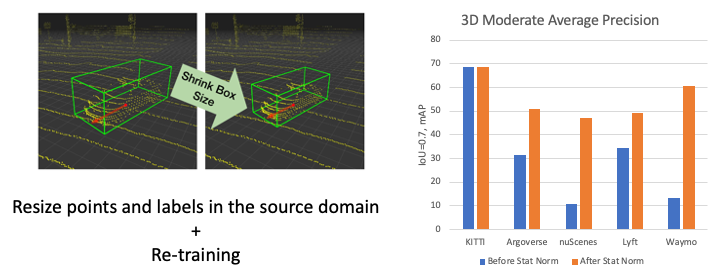This paper has been accpeted by Conference on Computer Vision and Pattern Recognition (CVPR) 2020.
Train in Germany, Test in The USA: Making 3D Object Detectors Generalize
by Yan Wang*, Xiangyu Chen*, Yurong You, Li Erran, Bharath Hariharan, Mark Campbell, Kilian Q. Weinberger, Wei-Lun Chao*
Prepare Datasets (Jupyter notebook)
We develop our method on these datasets:
- KITTI object detection 3D dataset
- Argoverse dataset v1.1
- nuScenes dataset v1.0
- Lyft Level 5 dataset v1.02
- Waymo dataset v1.0
-
Configure
dataset_pathin config_path.py.Raw datasets will be organized as the following structure:
dataset_path/ | kitti/ # KITTI object detection 3D dataset | training/ | testing/ | argo/ # Argoverse dataset v1.1 | train1/ | train2/ | train3/ | train4/ | val/ | test/ | nusc/ # nuScenes dataset v1.0 | maps/ | samples/ | sweeps/ | v1.0-trainval/ | lyft/ # Lyft Level 5 dataset v1.02 | v1.02-train/ | waymo/ # Waymo dataset v1.0 | training/ | validation/ -
Download all datasets.
For
KITTI,ArgoverseandWaymo, we provide scripts for automatic download.cd scripts/ python download.py [--datasets kitti+argo+waymo] -
Convert all datasets to
KITTI format.cd scripts/ python -m pip install -r convert_requirements.txt python convert.py [--datasets argo+nusc+lyft+waymo] -
Split validation set
We provide the
train/valsplit used in our experiments under split folder.cd split/ python replace_split.py -
Generate
carsubsetWe filter scenes and only keep those with cars.
cd scripts/ python gen_car_split.py
Statistical Normalization (Jupyter notebook)
-
Compute car size statistics of each dataset. The computed statistics are stored as
label_stats_{train/val/test}.jsonunder KITTI format dataset root.cd stat_norm/ python stat.py -
Generate rescaled datasets according to car size statistics. The rescaled datasets are stored under
$dataset_path/rescaled_datasetsby default.cd stat_norm/ python norm.py [--path $PATH]
We use PointRCNN to validate our method.
-
Setup PointRCNN
cd pointrcnn/ ./build_and_install.sh -
Build datasets in PointRCNN format.
cd pointrcnn/tools/ python generate_multi_data.py python generate_gt_database.py --root ...The
NuScencedataset has much less points in each bounding box, so we have to turn of theGT_AUG_HARD_RATIOaugmentation. -
Download the models pretrained on source domains from google drive using gdrive.
cd pointrcnn/tools/ gdrive download -r 14MXjNImFoS2P7YprLNpSmFBsvxf5J2Kw -
Adapt to a new domain by re-training with rescaled data.
cd pointrcnn/tools/ python train_rcnn.py --cfg_file ...
cd pointrcnn/tools/
python eval_rcnn.py --ckpt /path/to/checkpoint.pth --dataset $dataset --output_dir $output_dir We provide evaluation code with
- old (based on bbox height) and new (based on distance) difficulty metrics
- output transformation functions to locate domain gap
python evaluate/
python evaluate.py --result_path $predictions --dataset_path $dataset_root --metric [old/new]@inproceedings{wang2020train,
title={Train in germany, test in the usa: Making 3d object detectors generalize},
author={Yan Wang and Xiangyu Chen and Yurong You and Li Erran and Bharath Hariharan and Mark Campbell and Kilian Q. Weinberger and Wei-Lun Chao},
booktitle={Proceedings of the IEEE/CVF Conference on Computer Vision and Pattern Recognition},
pages={11713-11723},
year={2020}
}
